The papers below combine social network mapping techniques with fieldwork conducted in Egypt and Tunisia to analyze the shape and structure of the networked public sphere in the Arab region. The papers also examine the dynamics between the online and offline spheres and their relative impact on mobilization. The social network analysis is based on a regional map of the blogosphere; maps of Twitter networks in three countries: Egypt, Tunisia, and Bahrain; and a map of the Tunisian Facebook network. The fieldwork is based on in-depth interviews and focus groups with active members of the Egyptian and Tunisian networked public sphere in addition to nationally representative surveys. This mixed methods approach across these different platforms and regions offers a detailed view of social, cultural, religious, and political expression through digital media. Key observations include:
- The networked public sphere in the Arab region is much different than it was five years ago. With the decline in the blogosphere, Twitter and Facebook now host a large portion of the Arab networked public sphere.
- By all indications, the networked public sphere is more contentious, more highly polarized, and less conducive to broadly inclusive social mobilization, reflecting recent political shifts offline.
- In Egypt, the networked public sphere mirrors offline politics, including the presence and influence of traditional political powerhouses. On Twitter and Facebook, we see polarized debates that divide politically active users into three distinct and largely disconnected groups, in a close reflection of offline realities.
- In Bahrain, the antagonism between the government and opposition is manifest in a bipolar network structure on Twitter, and the debate is framed in sectarian language that appears intent on deepening the political divide.
- In Tunisia, we document the emergence of a flatter, less structured information system that allows individuals to contribute to the public sphere. The Twitter network is much more integrated and the discourse between political opponents less hostile, despite the political rivalries there.
- In each of these countries, the networked public sphere continues to offer a venue for civil society and individual voices that is less restrictive than traditional media.
Structure and Discourse: Mapping the Networked Public Sphere in the Arab Region
Robert Faris, John Kelly, Helmi Noman, Dalia Othman
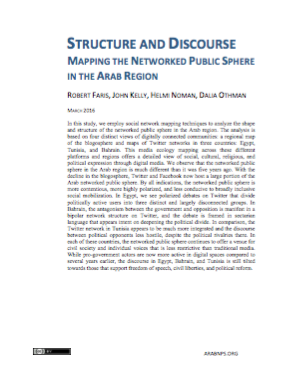 In this study, we employ social network mapping techniques to analyze the shape and structure of the networked public sphere in the Arab region. The analysis is based on four distinct views of digitally connected communities: a regional map of the blogosphere and maps of Twitter networks in three countries: Egypt, Tunisia, and Bahrain. This media ecology mapping across these different platforms and regions offers a detailed view of social, cultural, religious, and political expression through digital media. We observe that the networked public sphere in the Arab region is much different than it was five years ago. With the decline in the blogosphere, Twitter and Facebook now host a large portion of the Arab networked public sphere. By all indications, the networked public sphere is more contentious, more highly polarized, and less conducive to broadly inclusive social mobilization. In Egypt, we see polarized debates on Twitter that divide politically active users into three distinct and largely disconnected groups. In Bahrain, the antagonism between the government and opposition is manifest in a bipolar network structure on Twitter, and the debate is framed in sectarian language that appears intent on deepening the political divide. In comparison, the Twitter network in Tunisia appears to be much more integrated and the discourse between political opponents less hostile, despite the political rivalries there. In each of these countries, the networked public sphere continues to offer a venue for civil society and individual voices that is less restrictive than traditional media. While pro-government actors are now more active in digital spaces compared to several years earlier, the discourse in Egypt, Bahrain, and Tunisia is still tilted towards those that support freedom of speech, civil liberties, and political reform.
In this study, we employ social network mapping techniques to analyze the shape and structure of the networked public sphere in the Arab region. The analysis is based on four distinct views of digitally connected communities: a regional map of the blogosphere and maps of Twitter networks in three countries: Egypt, Tunisia, and Bahrain. This media ecology mapping across these different platforms and regions offers a detailed view of social, cultural, religious, and political expression through digital media. We observe that the networked public sphere in the Arab region is much different than it was five years ago. With the decline in the blogosphere, Twitter and Facebook now host a large portion of the Arab networked public sphere. By all indications, the networked public sphere is more contentious, more highly polarized, and less conducive to broadly inclusive social mobilization. In Egypt, we see polarized debates on Twitter that divide politically active users into three distinct and largely disconnected groups. In Bahrain, the antagonism between the government and opposition is manifest in a bipolar network structure on Twitter, and the debate is framed in sectarian language that appears intent on deepening the political divide. In comparison, the Twitter network in Tunisia appears to be much more integrated and the discourse between political opponents less hostile, despite the political rivalries there. In each of these countries, the networked public sphere continues to offer a venue for civil society and individual voices that is less restrictive than traditional media. While pro-government actors are now more active in digital spaces compared to several years earlier, the discourse in Egypt, Bahrain, and Tunisia is still tilted towards those that support freedom of speech, civil liberties, and political reform.
The Networked Public Sphere and Civic Engagement in Post-2011 Egypt: A Local Perspective
Nagla Rizk with Lina Attalah and Nadine Weheba
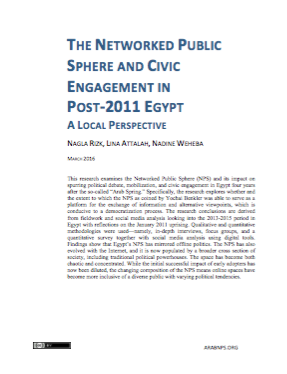 This research examines the Networked Public Sphere (NPS) and its impact on spurring political debate, mobilization, and civic engagement in Egypt four years after the so-called “Arab Spring.” Specifically, the research explores whether and the extent to which the NPS as coined by Yochai Benkler was able to serve as a platform for the exchange of information and alternative viewpoints, which is conducive to a democratization process. The research conclusions are derived from fieldwork and social media analysis looking into the 2013-2015 period in Egypt with reflections on the January 2011 uprising. Qualitative and quantitative methodologies were used—namely, in-depth interviews, focus groups, and a quantitative survey together with social media analysis using digital tools. Findings show that Egypt’s NPS has mirrored offline politics. The NPS has also evolved with the Internet, and it is now populated by a broader cross section of society, including traditional political powerhouses. The space has become both chaotic and concentrated. While the initial successful impact of early adopters has now been diluted, the changing composition of the NPS means online spaces have become more inclusive of a diverse public with varying political tendencies.
This research examines the Networked Public Sphere (NPS) and its impact on spurring political debate, mobilization, and civic engagement in Egypt four years after the so-called “Arab Spring.” Specifically, the research explores whether and the extent to which the NPS as coined by Yochai Benkler was able to serve as a platform for the exchange of information and alternative viewpoints, which is conducive to a democratization process. The research conclusions are derived from fieldwork and social media analysis looking into the 2013-2015 period in Egypt with reflections on the January 2011 uprising. Qualitative and quantitative methodologies were used—namely, in-depth interviews, focus groups, and a quantitative survey together with social media analysis using digital tools. Findings show that Egypt’s NPS has mirrored offline politics. The NPS has also evolved with the Internet, and it is now populated by a broader cross section of society, including traditional political powerhouses. The space has become both chaotic and concentrated. While the initial successful impact of early adopters has now been diluted, the changing composition of the NPS means online spaces have become more inclusive of a diverse public with varying political tendencies.
An Accelerated Story of the Emergence and Transformation of the Networked Public Sphere: The Case of Tunisia
Escander Nagazi, Jazem Halioui, Fares Mabrouk
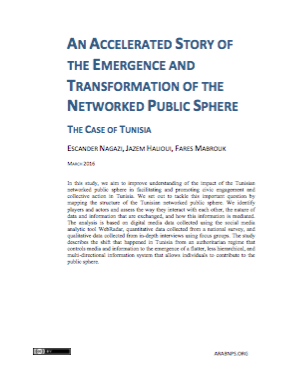 In this study, we aim to improve understanding of the impact of the Tunisian networked public sphere in facilitating and promoting civic engagement and collective action in Tunisia. We set out to tackle this important question by mapping the structure of the Tunisian networked public sphere. We identify players and actors and assess the way they interact with each other, the nature of data and information that are exchanged, and how this information is mediated. The analysis is based on digital media data collected using the social media analytic tool WebRadar, quantitative data collected from a national survey, and qualitative data collected from in-depth interviews using focus groups. The study describes the shift that happened in Tunisia from an authoritarian regime that controls media and information to the emergence of a flatter, less hierarchical, and multi-directional information system that allows individuals to contribute to the public sphere.
In this study, we aim to improve understanding of the impact of the Tunisian networked public sphere in facilitating and promoting civic engagement and collective action in Tunisia. We set out to tackle this important question by mapping the structure of the Tunisian networked public sphere. We identify players and actors and assess the way they interact with each other, the nature of data and information that are exchanged, and how this information is mediated. The analysis is based on digital media data collected using the social media analytic tool WebRadar, quantitative data collected from a national survey, and qualitative data collected from in-depth interviews using focus groups. The study describes the shift that happened in Tunisia from an authoritarian regime that controls media and information to the emergence of a flatter, less hierarchical, and multi-directional information system that allows individuals to contribute to the public sphere.
Civic Engagement and the Arab Networked Public Sphere: A Synthesis of Research Findings
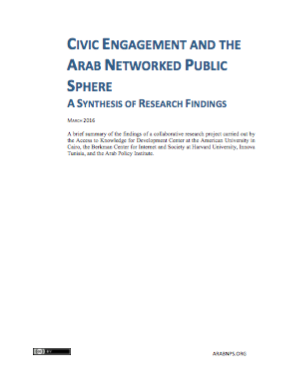 A brief summary of the findings of a collaborative research project carried out by the Access to Knowledge for Development Center at the American University in Cairo, the Berkman Center for Internet and Society at Harvard University, Innova Tunisia, and the Arab Policy Institute.
A brief summary of the findings of a collaborative research project carried out by the Access to Knowledge for Development Center at the American University in Cairo, the Berkman Center for Internet and Society at Harvard University, Innova Tunisia, and the Arab Policy Institute.
Studying the Arab Networked Public Sphere: A Reflection on Methods
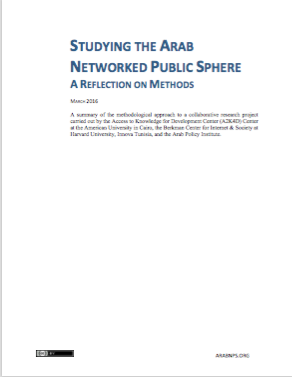 A summary of the methodological approach to a collaborative research project carried out by the Access to Knowledge for Development Center (A2K4D) at the American University in Cairo, the Berkman Center for Internet and Society at Harvard University, Innova Tunisia, and the Arab Policy Institute.
A summary of the methodological approach to a collaborative research project carried out by the Access to Knowledge for Development Center (A2K4D) at the American University in Cairo, the Berkman Center for Internet and Society at Harvard University, Innova Tunisia, and the Arab Policy Institute.